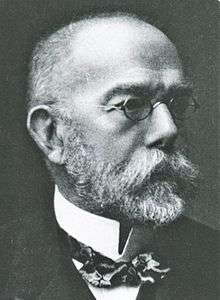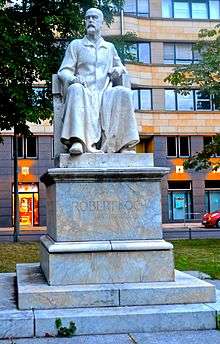Robert Koch
| Robert Koch | |
|---|---|
 | |
| Born |
Heinrich Hermann Robert Koch 11 December 1843 Clausthal, Kingdom of Hanover |
| Died |
27 May 1910 (aged 66) Baden-Baden, Grand Duchy of Baden, German Empire |
| Nationality | German |
| Alma mater | University of Göttingen |
| Known for |
Discovery bacteriology Koch's postulates of germ theory Isolation of anthrax, tuberculosis and cholera |
| Awards |
|
| Scientific career | |
| Fields | Microbiology |
| Institutions | Imperial Health Office, Berlin, University of Berlin |
| Doctoral advisor | Georg Meissner |
| Other academic advisors |
Friedrich Gustav Jakob Henle Karl Ewald Hasse Rudolf Virchow |
| Influenced | Friedrich Loeffler |
| Signature | |
 | |
Heinrich Hermann Robert Koch (English: /kɒk,
Early life and education
Koch was born in Clausthal, Germany, on 11 December 1842, to Hermann Koch (1814–1877) and Mathilde Julie Henriette (née Biewend; 1818–1871).[6] Koch excelled in academics from an early age. Before entering school in 1848, he had taught himself how to read and write.[4] He graduated from high school in 1862, having excelled in science and math.[4] At the age of 19, Koch entered the University of Göttingen, studying natural science.[7] However, after three semesters, Koch decided to change his area of study to medicine, as he aspired to be a physician.[4] During his fifth semester of medical school, Jacob Henle, an anatomist who had published a theory of contagion in 1840, asked him to participate in his research project on uterine nerve structure.[4] In his sixth semester, Koch began to conduct research at the Physiological Institute, where he studied the secretion of succinic acid, which is a signaling molecule that is also involved in the metabolism of the mitochondria.[4] This would eventually form the basis of his dissertation.[5] In January 1866, Koch graduated from medical school, earning honors of the highest distinction.[4]
Career
Several years after his graduation in 1866, he worked as a surgeon in the Franco-Prussian War, and following his service, worked as a physician in Wollstein in Prussian Posen (now Wolsztyn, Poland).[7] From 1880–85, Koch held a position as government advisor with the Imperial Department of Health.[8] Koch began conducting research on microorganisms in a laboratory connected to his patient examination room.[7] Koch’s early research in this laboratory yielded one of his major contributions to the field of microbiology, as he developed the technique of growing bacteria.[9] Furthermore, he managed to isolate and grow selected pathogens in pure laboratory culture.[9]
From 1885 to 1890, he served as an administrator and professor at Berlin University.[4]
In 1891, Koch relinquished his Professorship and became a director of the Prussian Institute for Infectious Diseases which consisted of a clinical division and beds for the division of clinical research. For this he accepted harsh conditions. The Prussian Ministry of Health insisted after the 1890 scandal with tuberculin, which Koch had discovered and intended as a remedy for tuberculosis, that any of Koch's inventions would unconditionally belong to the government and he would not be compensated. Koch lost the right to apply for patent protection.[10]
Research
Isolating pure bacterial cultures
In an attempt to grow bacteria, Koch began to use solid nutrients such as potato slices.[9] Through these initial experiments, Koch observed individual colonies of identical, pure cells.[9] He found that potato slices were not suitable media for all organisms, and later began to use nutrient solutions with gelatin.[9] However, he soon realized that gelatin, like potato slices, was not the optimal medium for bacterial growth, as it did not remain solid at 37 °C, the ideal temperature for growth of most human pathogens.[9] As suggested to him by Walther and Fanny Hesse, Koch began to utilize agar to grow and isolate pure cultures, because this polysaccharide remains solid at 37 °C, is not degraded by most bacteria, and results in a transparent medium.[9][11]
Koch's four postulates
During his time as government advisor, Koch published a report, in which he stated the importance of pure cultures in isolating disease-causing organisms and explained the necessary steps to obtain these cultures, methods which are summarized in Koch’s four postulates.[12] Koch’s discovery of the causative agent of anthrax led to the formation of a generic set of postulates which can be used in the determination of the cause of most infectious diseases.[13] These postulates, which not only outlined a method for linking cause and effect of an infectious disease but also established the significance of laboratory culture of infectious agents, are listed here:[13]
- The organism must always be present, in every case of the disease.
- The organism must be isolated from a host containing the disease and grown in pure culture.
- Samples of the organism taken from pure culture must cause the same disease when inoculated into a healthy, susceptible animal in the laboratory.
- The organism must be isolated from the inoculated animal and must be identified as the same original organism first isolated from the originally diseased host.
Anthrax
Robert Koch is widely known for his work with anthrax, discovering the causative agent of the fatal disease to be Bacillus anthracis.[13] He discovered the formation of spores in anthrax bacteria, which could remain dormant under specific conditions.[7] However, under optimal conditions, the spores were activated and caused disease.[7] To determine this causative agent, he dry-fixed bacterial cultures onto glass slides, used dyes to stain the cultures, and observed them through a microscope.[4] His work with anthrax is notable in that he was the first to link a specific microorganism with a specific disease, rejecting the idea of spontaneous generation and supporting the germ theory of disease.[13]
Tuberculosis

During his time as the government advisor with the Imperial Department of Health in Berlin in the 1880s, Robert Koch became interested in tuberculosis research.[4] At the time, it was widely believed that tuberculosis was an inherited disease.[4] However, Koch was convinced that the disease was caused by a bacterium and was infectious, and tested his four postulates using guinea pigs.[4] Through these experiments, he found that his experiments with tuberculosis satisfied all four of his postulates.[4] In 1882, he published his findings on tuberculosis, in which he reported the causative agent of the disease to be the slow-growing Mycobacterium tuberculosis.[9] Later, Koch's attempt at developing a drug to treat tuberculosis, tuberculin, led to a scandalous failure: he did not divulge the exact composition, and the claimed treatment success did not materialize; the substance is today used for tuberculosis diagnosis.
Dr. Koch and his relationship to Doctor Paul Ehrlich, who developed a mechanism to diagnose TB, were portrayed in the 1940 movie Dr. Ehrlich's Magic Bullet.
Cholera
Koch next turned his attention to cholera, and began to conduct research in Egypt in the hopes of isolating the causative agent of the disease.[7] However, he was not able to complete the task before the epidemic in Egypt ended, and subsequently traveled to India to continue with the study.[4] In 1884 in Bombay state of India, Koch resided and researched at Grant Medical College, where he was able to determine the causative agent of cholera, isolating Vibrio cholerae.[4][14] The bacterium had originally been isolated in 1854 by Italian anatomist Filippo Pacini,[15] but its exact nature and his results were not widely known.
Acquired immunity
Koch observed the phenomenon of acquired immunity. On December 26, 1900, he arrived as part of an expedition to German New Guinea, which was then a protectorate of the German Reich. Koch serially examined the Papuan people, the indigenous inhabitants, and their blood samples and noticed they contained Plasmodium parasites, the cause of malaria, but their bouts of malaria were mild or could not even be noticed, i.e. were subclinical. On the contrary, German settlers and Chinese workers, who had been brought to New Guinea, fell sick immediately. The longer they had stayed in the country, however, the more they too seemed to develop a resistance against it.[16]
Awards and honors

In 1897, Koch was elected a Foreign Member of the Royal Society (ForMemRS).[1] In 1905, Koch won the Nobel Prize in Physiology and Medicine for his work with tuberculosis.[4] In 1906, research on tuberculosis and tropical diseases won him the Prussian Order Pour le Merite and in 1908, the Robert Koch medal, established to honour the greatest living physicians.[4]
Koch's name is one of twenty-three, from the fields of hygiene and tropical medicine, featured on the frieze of the London School of Hygiene & Tropical Medicine building in Keppel Street, Bloomsbury.[17]
A large marble statue of Koch stands in a small park known as Robert Koch Platz, just north of the Charity Hospital, in the Mitte section of Berlin. His life was the subject of a 1939 German produced motion picture that featured Oscar winning actor Emil Jannings in the title role. On 10 December 2017, Google showed a Doodle in celebration of Koch's birthday.[18][19]
Personal life
In July 1867, Koch married Emma ( Emmy) Adolfine Josephine Fraatz, and the two had a daughter, Gertrude, in 1868.[5] Their marriage ended after 26 years in 1893, and later that same year, he married actress Hedwig Freiberg (1872–1945).[5]
On 9 April 1910, Koch suffered a heart attack and never made a complete recovery.[4] On 27 May, three days after giving a lecture on his tuberculosis research at the Prussian Academy of Sciences, Koch died in Baden-Baden at the age of 66.[7] Following his death, the Institute named its establishment after him in his honour.[4] He was irreligious.[20]
References
- 1 2 "Fellows of the Royal Society". London: Royal Society. Archived from the original on 2015-03-16.
- ↑ "Koch". Random House Webster's Unabridged Dictionary.
- ↑ "Koch". The American Heritage Dictionary of the English Language, Houghton Mifflin Harcourt
- 1 2 3 4 5 6 7 8 9 10 11 12 13 14 15 16 17 18 19 "Robert Koch." World of Microbiology and Immunology. Ed. Brenda Wilmoth Lerner and K. Lee Lerner. Detroit: Gale, 2006. Biography In Context. Web. 14 Apr. 2013.
- 1 2 3 4 5 6 Brock, Thomas. Robert Koch: A life in medicine and bacteriology. ASM Press: Washington DC, 1999. Print.
- ↑ Metchnikoff, Elie. The Founders of Modern Medicine: Pasteur, Koch, Lister. Classics of Medicine Library: Delanco, 2006. Print.
- 1 2 3 4 5 6 7 "Heinrich Hermann Robert Koch." World of Scientific Discovery. Gale, 2006. Biography In Context. Web. 14 April 2013.
- ↑ O’Connor, T.M. "Tuberculosis, Overview." International Encyclopedia of Public Health. 2008. Web.
- 1 2 3 4 5 6 7 8 Madigan, Michael T., et al. Brock Biology of Microorganisms: Thirteenth edition. Benjamin Cummings: Boston, 2012. Print.
- ↑ Christoph Gradmann: Laboratory Disease, Robert Koch's Medical Bacteriology. The Johns Hopkins University Press, Baltimore 2009, ISBN 978-0-8018-9313-1, p. 111 ff.
- ↑ Robert Koch (10 April 1882). "Die Aetiologie der Tuberculose" [The etiology of tuberculosis]. Berliner Klinische Wochenschrift (Berlin Clinical Weekly). 19: 221–30.
From page 225: "Die Tuberkelbacillen lassen sich auch noch auf anderen Nährsubstraten kultivieren, wenn letztere ähnliche Eigenschaften wie das erstarrte Blutserum besitzen. So wachsen sie beispielsweise auf einer mit Agar-Agar bereiteten, bei Blutwärme hart bleibenden Gallerte, welche einen Zusatz von Fleischinfus und Pepton erhalten hat." (The tubercule bacilli can also be cultivated on other media, if the latter have properties similar to those of congealed blood serum. Thus they grow, for example, on a gelatinous mass prepared with agar-agar, which remains solid at blood temperature, and which has received a supplement of meat broth and peptone.)
- ↑ Amsterdamska, Olga. "Bacteriology, Historical." International Encyclopedia of Public Health. 2008. Web.
- 1 2 3 4 "Germ theory of disease." World of Microbiology and Immunology. Ed. Brenda Wilmoth Lerner and K. Lee Lerner. Detroit: Gale, 2007. Biography In Context. Web. 14 April 2013.
- ↑ Koch notes comma shape of bacterium, describes pure in vitro colonies of Vibrio cholerae, and notes relation between presence of Vibrio cholerae and emergence and progress of cholera: Koch, R. (March 20, 1884) "Sechster Bericht der Leiters der deutschen wissenschaftlichen Commission zur Erforschung der Cholera" (Sixth report of the head of the German scientific commission for research on cholera), Deutsche medizinische Wochenscrift (German Medical Weekly), 10 (12): 191-192. On page 191, he mentions the characteristic comma shape of Vibrio cholerae: "Im letzten Berichte konnte ich bereits gehorsamst mittheilen, dass an den Bacillen des Choleradarms besondere Eigenschaften aufgefunden wurden, durch welche sie mit aller Sicherheit von anderen Bakterien zu unterscheiden sind. Von diesen Merkmalen sind folgende die am meisten charakteristischen: Die Bacillen sind nicht ganz geradlinig, wie die übrigen Bacillen, sondern ein wenig gekrümmt, einem Komma ähnlich." (In the last report, I could already respectfully report that unusual characteristics were discovered in the bacteria of enteric cholera, by which they are to be distinguished with complete certainty from other bacteria. Of these features, the following are the most characteristic: the bacteria are not quite straight, like the rest of the bacilli, but a little bent, similar to a comma.)
- ↑ See:
- Fillipo Pacini (1854) "Osservazioni microscopiche e deduzioni patologiche sul cholera asiatico" (Microscopic observations and pathological deductions on Asiatic cholera), Gazzetta Medica Italiana: Toscana, 2nd series, 4(50):397–401; 4(51):405–12.
- Reprinted (more legibly) as a pamphlet.
- ↑ Hugo Kronecker: Hygienische Topographie In: A. Pfeiffer (Editor): 21. Jahresbericht über die Fortschritte und Leistungen auf dem Gebiete der Hygiene. 1903. Publisher: Friedrich Vieweg und Sohn, Braunschweig, 1905. p. 68
- ↑ "London School of Hygiene & Tropical Medicine, Behind the Frieze".
- ↑ https://www.google.com/doodles/celebrating-robert-koch
- ↑ https://www.youtube.com/watch?v=lEeBZceXjfg
- ↑ Thomas D. Brock (1988). Robert Koch: A Life in Medicine and Bacteriology. ASM Press. p. 296. ISBN 9781555811433. "He loved seeing new things, but showed no interest in politics. Religion never entered his life."
Further reading
- Brock, Thomas D. (1999). Robert Koch: A Life in Medicine and Bacteriology. Washington, D.C.: ASM Press. ISBN 978-1-55581-143-3. OCLC 39951653.
- Morris, Robert D (2007). The blue death: disease, disaster and the water we drink. New York: Harper Collins. ISBN 978-0-06-073089-5. OCLC 71266565.
- Gradmann, Christoph (2009). Laboratory Disease: Robert Koch's Medical Bacteriology. Baltimore: Johns Hopkins University Press. ISBN 978-0-8018-9313-1.
- Weindling, Paul. "Scientific elites and laboratory organization in fin de siècle Paris and Berlin: The Pasteur Institute and Robert Koch’s Institute for Infectious Diseases compared," in Andrew Cunningham and Perry Williams, eds. The Laboratory Revolution in Medicine (Cambridge University Press, 1992) pp: 170–88.
- Christoph, Hans Gerhard: Robert Koch " Trias deutschen Forschergeistes " Naturheilpraxis / Pflaum- Verlag / Munich 70.Jahrgang December 2017 page 90-93
External links
| Wikimedia Commons has media related to Robert Koch. |
- Robert Koch Biography at the Nobel Foundation website
- MPIWG-Berlin, Robert Koch Biography and bibliography in the Virtual Laboratory of the Max Planck Institute for the History of Science
- Biography on the Science Museum web site
- Musoptin.com, original microscope out of the laboratory Robert Koch used in Wollstein (1877)
- Musoptin.com, microscope objectives: as they were used by Robert Koch for his first photos of microorganisms (1877–1878)
- Works by Robert Koch at Project Gutenberg
- Works by or about Robert Koch at Internet Archive
- Newspaper clippings about Robert Koch in the 20th Century Press Archives of the German National Library of Economics (ZBW)

- "Koch, Robert". Encyclopedia Americana. 1920.
- "Koch, Robert". Encyclopædia Britannica (11th ed.). 1911.
- "Koch, Robert". New International Encyclopedia. 1905.